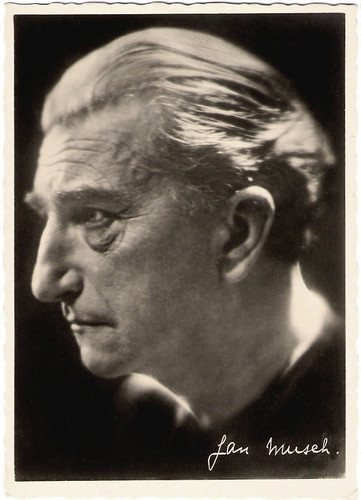
Dutch postcard by REB in the series Portrettengalerij, no. 105.
A quiet charm
Jan Musch was born as Johannes Petrus Musch in 1875 in De Jordaan, the heart of old Amsterdam. His father, a café owner, was offered theatre tickets for showing posters in his café. So young Jan saw a lot of stage plays and soon wanted to become an actor too.
Musch also showed talent for drawing and music. He performed as a magician, together with his friend Johan Buziau, who would later become one of the great clowns of the Dutch theatre.
Jan started his stage career in the choir of the revue 'De Doofpot' (The Extinguisher) in the Salon des Variétés in Amsterdam. In the following years, he worked as an extra, singer or dresser, and also played the piano in harbour bars.
At 17, he got his first paid stage job as a servant in the classic Dutch play 'Spiegel der vaderlandse kooplieden' (Mirror of the National Merchants). He was influenced by the naturalistic, romantic acting style of the great actor Louis Bouwmeester.
Actress Esther de Boer-Van Rijk noticed him and took care that he got an engagement at the Nederlandsche Toneelvereeniging in 1899. Under the direction of Herman Heyermans, he became one of the great Dutch actors of the early 20th century in plays like 'Allerzielen' (All Souls’ Day). His acting style changed into a quiet charm, simple and withdrawn.
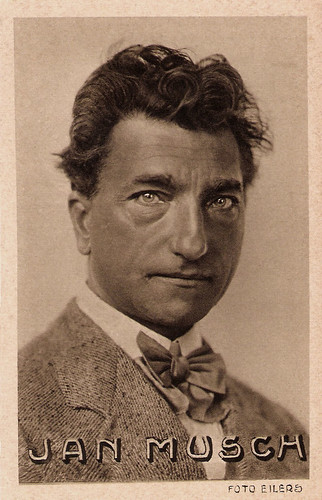
Dutch postcard in the series Hollandsche Kunstenaars (Dutch Artists). no. 1. Photo: Bernard Eilers.
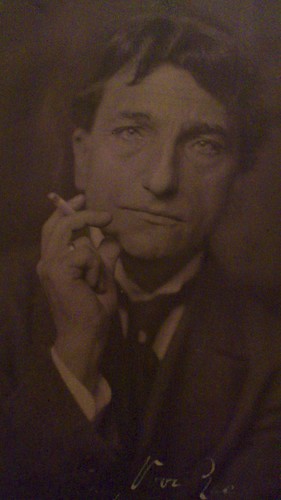
Dutch postcard. Collection: Britta K @ Flickr.
Grand character actor
From 1909 to 1915, Jan Musch was one of the main actors in the company of Willem Royaards, which would prove to be another main period of his stage career.
He became a grand character actor in the classic plays of Joost van den Vondel, like 'Lucifer' and 'Gijsbreght', and of William Shakespeare, like 'The Merchant of Venice' and 'A Midsummer Night’s Dream'.
In 1916, he returned to Heyermans and his Nieuwe Nederl. Tooneel-Vereeniging, which performed in the Grand Théâtre in Amsterdam. Musch became the co-director. He played the title roles in two classic Dutch plays, Bredero's 'Spaanse Brabander' (The Spanish Man of Brabant) and Pieter Langendijk’s 'Krelis Louwen', which he would perform again and again during the next decades.
With his great comic talent, he was also an ideal interpreter of the plays by Molière, such as the miser Harpagon in 'L’avare' (The Miser).
In the following decades, Musch stayed a vital star and attraction of the different companies he worked for. In 1928, he made a successful tour in the Dutch West Indies. Privately, he was reserved and never gave interviews.
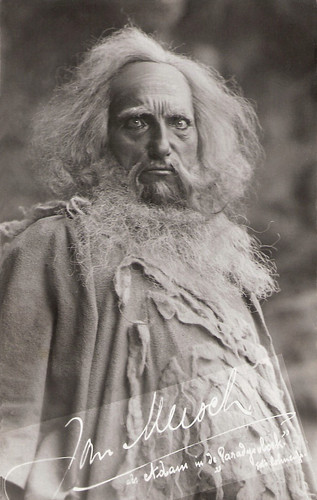
Dutch postcard. Photo: Cohnen Jr. Publicity still for the stage play De paradijsvloek (1919) by Alphons Laudy. The original production by het Schouwtooneel with Musch as Adam was a huge success in both the Netherlands and Flanders.
Underground
During the 1930s, Jan Musch often worked together with the actress Else Mauhs. With her and with actor Ko Arnoldi, he formed in 1933 the theatre company Het Masker (The Mask), which existed till 1936.
During this period, he also appeared in a few films. He starred as a doomed fisherman of the Zuiderzee (Southern Sea) in the drama Dood water / Dead Water (Gerard Rutten, 1934) with Max Croiset. The film won an award at the Venice Film Festival. Musch also appeared in De Man zonder hart / The Man Without a Heart (Leo Joannon, 1937), and as a signal man in the thriller De spooktrein / The Ghost Train (Carl Lamac, 1939) with Fien de la Mar and Adolphe Engers.
In 1939, he retired because of ill health. In the first year of the war, the Vlaamse Schouwburg in Antwerpen (Antwerp), Belgium, asked him to reprise his role in Molière’s 'L’avare', which he did to great acclaim.
When the Nazis introduced the fascist Kulturkammer in the Netherlands, Musch refused to join. His first wife, the violinist Ans Benavente, had tried to escape through France, but was killed by the Nazis. Musch started to perform underground, and with his second wife, actress Mary Smithuyzen, he helped the Dutch resistance. Therefore, he had to flee in 1943.
After the war, he started a political cabaret and performed many of his old roles on the radio. After a successful tour through Surinam in 1949 and his last film role in Myrte en de Demonen / Myrte of the Demons (Paul Bruno Schreiber, 1950), he decided to make a farewell theatre tour with 'L’avare' in 1952. The 77-year-old Jan Musch had shone magically on the stage for more than six decades. Recovering after a stroke, he died in 1960 in his hometown of Blaricum, Netherlands.
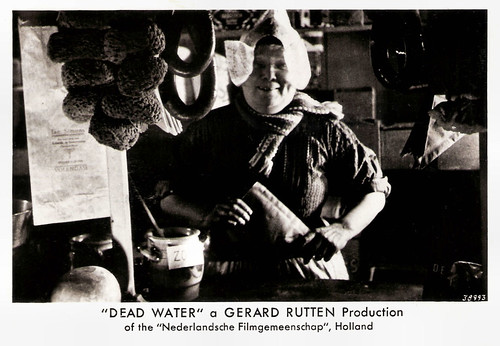
Dutch postcard, no. 38993. Photo: Nederlandse Filmgemeenschap, Holland. Publicity still for Dood water / Dead water (Gerard Rutten, 1934). Collection: Geoffrey Donaldson Institute.
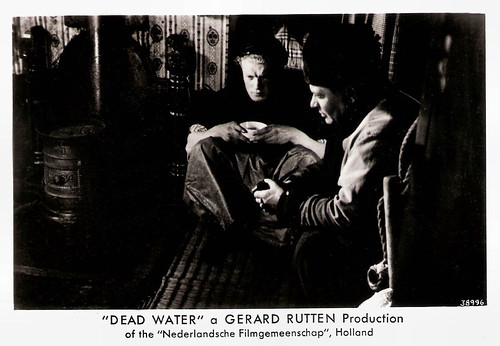
Dutch postcard, no. 38996. Photo: Nederlandse Filmgemeenschap, Holland. Publicity still for Dood water/Dead water (Gerard Rutten, 1934) with Max Croiset and Arnold Marlé. Collection: Geoffrey Donaldson Institute.
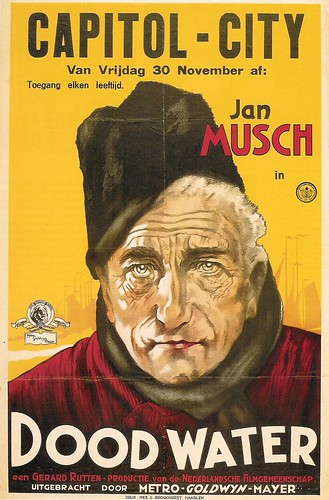
Dutch poster for the film Dood water / Dead Water (Gerard Rutten, 1934) starring Jan Musch.
Sources: Theun de Vries (DBNL - Dutch), Wikipedia (Dutch), and IMDb.
This post was last updated on 26 November 2025.
No comments:
Post a Comment